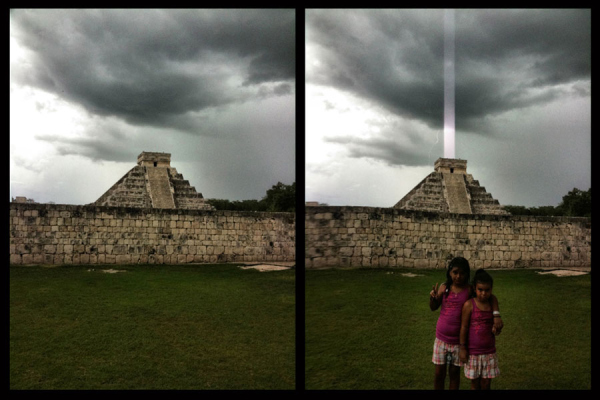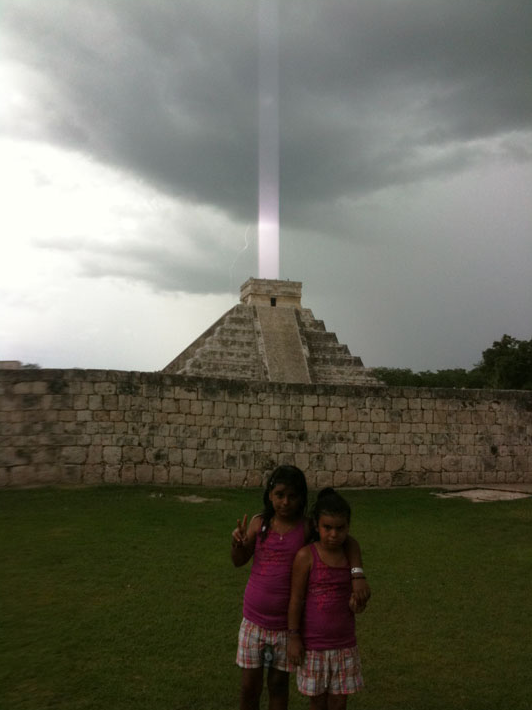Richard C. Hoagland, the official Coast to Coast AM science advisor (shudder), was on C2C last night for the first time with new-to-2012 host John B. Wells.
Among the images that Richard provided for the audience is the one below, and the caption was taken directly from the C2C website:

Lunar Ziggurat Redux?
The fact that he's presenting this image as genuine is one thing. But the further fact that he writes in there, "and, after investigation, proved to NOT be a hoax," is icing. I mean, seriously? Even the lunar ziggurat looked more genuine than this does.
Some digging shows that this was not taken "last year," but back in 2009. July 24, 2009, actually - or at least as far as I can tell. In fact, at that link, we can get a higher-resolution version:
Manipulation Between Hoagland's and the "Original"
One can already see that either Hoagland or someone else before it got to Hoagland had manipulated the image: Contrast had been increased, colors saturated, and things overall darkened except for the beam (look at the clouds to the lower left of the pyramid in Hoagland's versus the 2009 version - they're darker but the beam is lighter). One can easily do this with a Curves and a Saturation layer in Photoshop or similar graphics software.
It also appears as though a rectangular area of grass around the girls has been lightened relative to the surrounding grass. In the 2009 version, the grass is of generally uniform luminosity (brightness). On a brightness scale of 0-255, the G (green) value is around 40-50 for the grass throughout the image. But in Hoagland's the G is around 40-45 on the periphery of the image, but 50-60 near the girls - about 20% brighter.
In fact, this extends not just from the grass, to to the sky surrounding the steps of the pyramid itself. In the sky to the right of the "original" version from Flickr, the greyscale value is roughly 105-115. In Hoagland's version, it's around 140-150 until you get close to the pyramid, and there it's 160-175 or so.
I'm NOT saying that it was Richard Hoagland who made these changes. What I am saying is that it's possible he did, but it's definite that someone did between the 2009 version and what he presented last night.
Manipulation of the Original to the "Original"
There has also been some clear manipulation of the original that was posted to the Flickr stream that I'm calling the "original" that's the real subject of debate.
The most obvious manipulation is to the left-hand side. It's smeared. This is not something that can be caused by movement when holding the camera - if the camera moved, then the whole image would be blurry, not just the left 10% or so. This has nothing to do with the beam, but it clearly shows that the image shown in 2009 was NOT original as-taken-by-the-camera.
Then there's of course the obvious - the "beam" of pink. I can't prove it's fake without the original or without a confession; all I can do is present a case that it's more likely to be fake than real. Other than it looking fake, it defies some basic assumptions. Well, one mainly: It's straight up-and-down with the image, but the image is not straight up-and-down relative to gravity.
What I mean is that the person who took the photo did not have the camera exactly vertical, it was tilted by a few degrees clockwise. You can tell this by the pyramid looking tilted and by measuring the should-be vertical walls up to the top of the pyramid - they're tilted by a few degrees.
The beam, however, is not. It is exactly vertical relative to the edges of the photograph. That means that, if this were real, the beam would not be vertical, but it would have been tilted. Even the aliasing (slight shading as you transition from the beam to the sky) is exactly vertical, the same column of pixels up and down. That very strongly implies that someone made a rectangle in Photoshop, filled it with a gradient, and set the blending mode to color. Or some similar process.
In fact ...
Look! A Beam of Yellow Greed Energy Shooting from the US Capitol Building!
Looks about as genuine as the pink energy beam from the Kukulkan pyramid.
Moving On ...
Searching around the internet finds that this has been discussed before. For example, there's a Project Avalon Forum thread on the topic from 2010 that's three pages long. These are people who really want to believe this is real. But even some of them are having issues with it. Things that jump out at me as highly suspect:
- Originals have not been released for independent analysis.
- The tourists claim that they did not see it by eye, only in the photo1.
- Can't find the original supposed photographer(s).
- EXIF data (metadata) on the image which people were using to claim it's original can be easily changed with software.
- One of the original proponents/presenters has a history of hoaxing.
- It was presented by a UFO researcher as part of claims for UFO evidence, not Richard's would-be pink hyperdimensional energy triggered by a thunderstorm.
- The photo was allegedly studied by "experts," but who those people are and what experience they have is never mentioned nor referenced.
1This is a big red flag (similar with "ghost orbs" and other stuff). Cameras are designed to mimic the human eye. It wouldn't do well for them to image things the eye can't see because people take photos wanting to remember what they saw. To miss a giant pink energy beam strains credulity. The idea of, "Well, maybe it was just really brief and they managed to catch it in this photo!" also strains credulity because of the requisite timing - they'd have to somehow be lucky enough to click that iPhone shutter button at that exact moment of the beam they didn't see with their eye and that (likely) 1/100th of a second happened to coincide with this incredibly brief burst of energy.
Final Thoughts
As with the ziggurat, I am NOT stating that Richard made this himself, that he hoaxed it. I'm also NOT stating with 100% certainty that this is a hoax.
What I am saying boils down to three primary items:
1. The version of the image that Richard presented last night shows significant manipulation from the "original." Someone must have done the manipulation, and it may have been him.
2. The "original" version shows several red flags that indicate image manipulation and that the "beam" was placed in the image after it was taken with software. It is also easily duplicated in basic image processing software.
3. The original is not available for independent analysis, and the custody history of the photo raises numerous red flags.
In private conversation, I'd say this is clearly fake. In pure objective discussion, I present you with the above, and I think that the most likely explanation is that this was hoaxed by someone and is not a real phenomenon.
That Richard presents it as "proved to NOT be a hoax" - as I said in my original post on the lunar ziggurat, shows that (in my opinion) Richard C. Hoagland is incompetent with image analysis. If he or someone else were to explain the above red flags with something plausible, I'm all ears.





Reader Comments
to our Newsletter